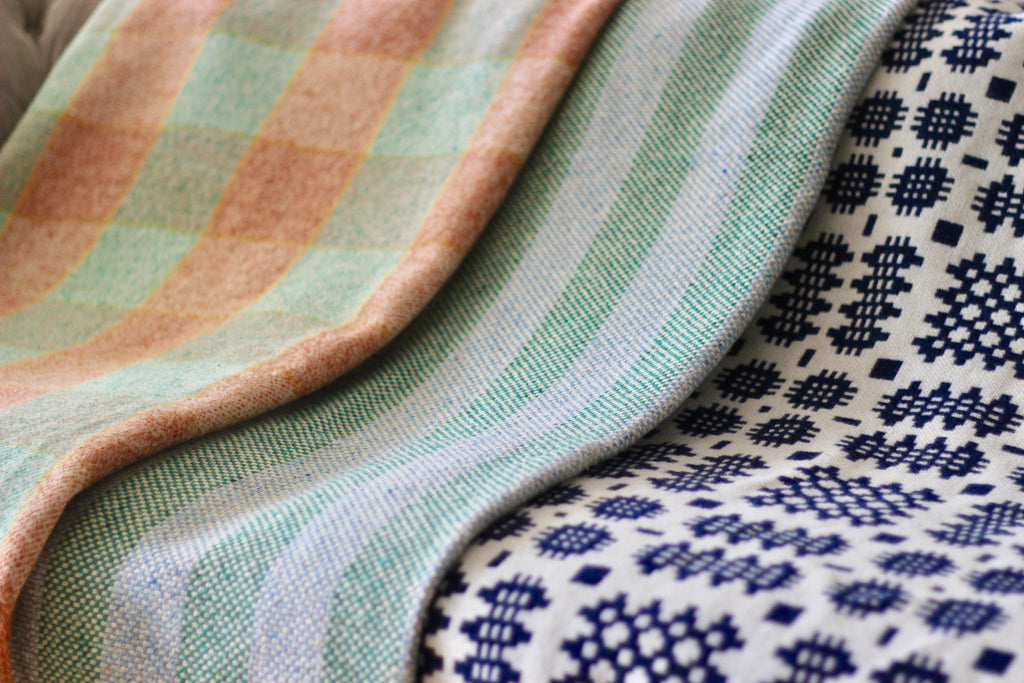
Now adorning boutique hotel beds, hipster yurts, and boho coffee venues across the country, the traditional Welsh tapestry blanket is enjoying a resurgence, riding the waves of the ethnic/artisan trend.
We are not surprised here at Welsh Otter – the striking iconic pattern, bright bold colours, and craftsmanship is unique and in our opinion one of Wale’s biggest design treasures.
But what is the story behind our beautiful Welsh blankets?
Textile production has been at the heart of Welsh village life for centuries, taking place in cottages, outhouses and sitting rooms. Few communities existed without the rattle of the spinning wheel or the clank of the small home loom, providing a backdrop to Welsh rural life. Wales proved the perfect country for making woollen textiles, due to fast flowing mountain streams providing power, and of course the sheep to provide their cosy fleeces.
As large melinau gwlan (woollen mills) were built in the 1860s onwards, production focused on producing practical clothing and flannel to be exported far and wide – including to miners in south wales, cotton pickers in North America, and even red coat soldiers in India.
The boom in the tourist trade in the 1930s brought with it a refocus on bright, attractive, blanket designs, including the famous tapestry blanket, but also carthenni (bedcovers), which usually had a characteristic check design, and honeycomb quilts.
The tapestry quilt is essentially a double cloth fabric, which is created by two cloths being woven on top of each other, creating the ultimate double-sided design (two blankets for the price of one!). Some fascinating original designs dating from 1760 by the weaver William Jones of Holt can be seen at the Clwyd Record Office, with many of these patterns still being produced today.
Each mill tended to have its own unique series of designs, however the one that is most iconic is the Traditional Caernarvon design, or ‘portcullis’, a very old design consisting of a repeated series of pixilated squares, spikes and dots. This was produced in bright contrasting colours – greens, oranges, purples.
The blankets produced today are still produced in much the same manner as they have for over 100 years, by many of the same mills. The Welsh design has influenced folk and crafts in North America and beyond, with exports to Asia, Japan and America.
Unfortunately, the number of mills has reduced from over 300 in its 1895 heyday, to only a handful across Wales now. These mills are now the guardians of the industry, and are in the privileged position to continue and pass on the skills and craftsmanship.
We visited Elvet Mill near Carmarthen, where Mike has been at the helm for 36 years, producing beautiful designs on dobcross looms, including an unusual ‘Pennsylvania’ design. Melin Rock in Capel Dewi is the only mill in Wales still powered by water in the traditional manner (you can stay there -http://www.rockmillwales.co.uk/accommodation.php)

If you don’t go anywhere else – the wonderful National Wool Museum of Wales is a must (Dre-fach Felindre, Carmarthenshire). The museum is a celebration of the woollen industry, taking you through the weaving process from fleece to blanket, set across three floors of the old Cambrian mill, now restored. I loved the collection of vintage blankets http://www.rockmillwales.co.uk/accommodation.php (great for inspiration), and the beautifully upholstered life size stag and boar, created using welsh textiles (I would love a smaller version for my sitting room).
The big challenge facing the industry now is keeping the few remaining mills going. Ironically as demand increases, the mills are facing new challenges such as skill retention, transfer of knowledge to the new generation, and upkeep of the machinery that is such as central part of the craft.
Fancy supporting the remaining Welsh mills and also bagging yourself a cosy heirloom? Take a look at our fab collection now, all made in Wales.



